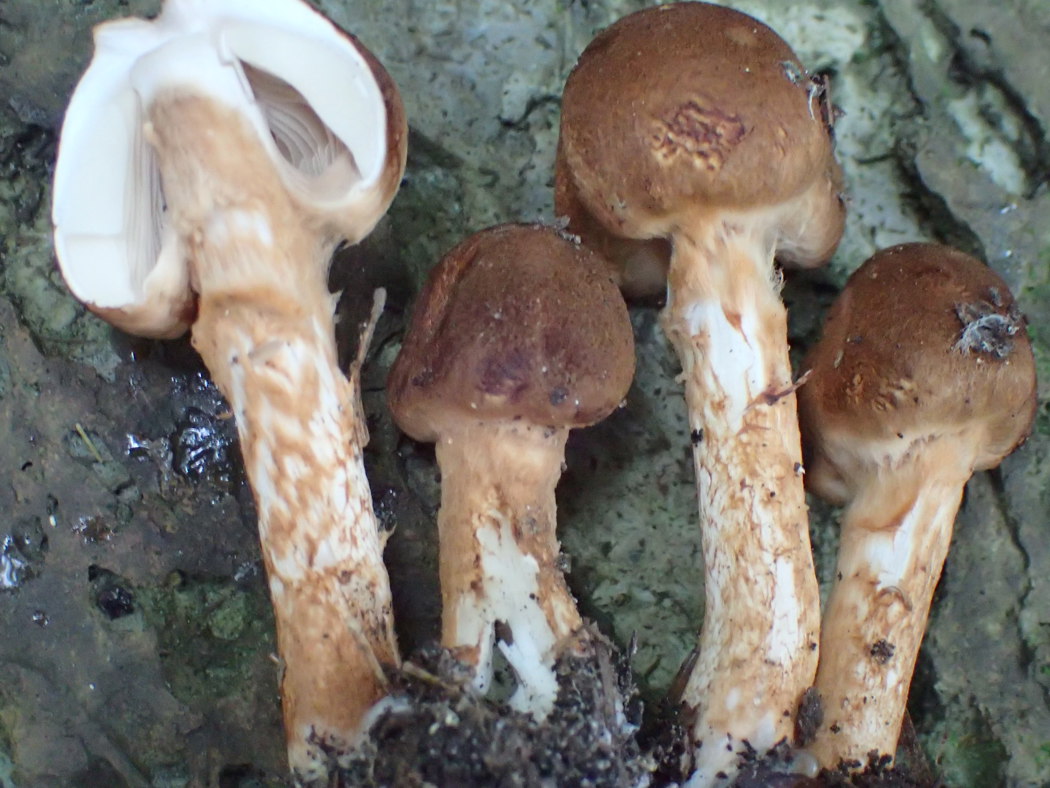Good advice when picking mushrooms
- Only eat mushrooms you are 100% sure are safe.
- Never taste an unknown mushroom! Even a poisonous mushroom can have a mild flavour.
- Use up-to-date literature on mushrooms.
- Throw away all worm-eaten or rotten mushrooms.
Hepatotoxic mushrooms
Toxicity
Even very small amounts of these mushrooms can cause severe poisoning. Clinical signs occur after a minimum of 6 hours, and include watery diarrhoea, abdominal pain and vomiting. There is a high risk of life-threatening liver damage within 2 - 3 days.
If you suspect you have ingested this mushroom, contact the Norwegian Poisons Information Centre for advice.
Destroying angel

Amanita virosa (Norwegian: Hvit fluesopp)
Illustration: Per Marstad
The entire mushroom is white (cap, stem, gills and flesh). On the stalk there is a ring, but this might fall off. The base of the stalk has a sheeting volva (bag). Destroying angel is common in forests
Death cap

Amantia phalloides (Norwegian: Grønn fluesopp)
Illustration: Per Marstad
The colour of the cap can vary from green to brown and yellow. The gills and the stalk are white. On the stalk there is a ring, but this might fall off. The base of the stalk has a sheeting volva (bag). Death cap is rare in Norway.
Chestnut dapperling

Lepiota castanea (Norwegian: Kastanjeparasollsopp)
Illustration: Per Marstad
The cap is red brown and scaly. The gills and flesh are white. The stalk is brown. This is a small mushroom.
Funeral bell

Galerina marginata (Norwegian: Flatklokkehatt)
Illustration: Per Marstad
The cap and gills are yellow–brown. The stalk varies from grey to brown. This is a small mushroom, usually found in clusters on bark and tree stumps. Funeral bell is common in Norway.
Girdled dapperling

Lepiota boudieri (Norwegian: Rustbrun parasollsopp)
Illustration: Per Marstad
The cap is bell shaped, yellow brown and scaly. The gills are white. This mushroom is small and grows in deciduous forests.
Nephrotoxic mushrooms
Toxicity
Even a very small amount of the two webcaps contains enough poison to cause severe kidney damage. Clinical signs do not appear until at least 2 days after ingestion. These include nausea, abdominal pain, malaise and increased or reduced amount of urine.
There is a high risk of developing severe kidney failure within a period of 3 – 10 days. If you suspect you have ingested these webcaps, contact the Norwegian Poisons Information Centre for advice.
Deadly webcap

Cortinarius Rubellus (Norwegian: Spiss giftslørsopp)
Illustration: Per Marstad
The entire mushroom is reddish-brown (cap, stipe, gills and flesh). Deadly webcap is common in forests.
Fool’s webcap

Cortinarius orellanus (Norwegian: Butt giftslørsopp)
Illustration: Per Marstad
Looks like the deadly webcap, but has a rounded cap. Fool’s webcap is a rare mushroom growing in deciduous forests.
Dangerous misidentification

Illustration: Per Marstad
Deadly webcap grow in the same places as the edible Trumpet chanterelle (Craterellus tubaeformis), and the two species are similar in colour (see photo). It is important to check each mushroom you collect to make sure the deadly webcap is not mixed in with any edible chanterelles.
Other poisonous mushrooms
Red fly agaric / Brown fly agaric / Panther agaric

Amanita muscaria/ A. regalis / A. pantherina (Norwegian: Rød / Brun / Panter fluesopp)
Illustration: Per Marstad
These mushrooms have white gills and a stalk with a ring. The base of the stalk is bulbous. The cap is reddish or brownish in colour, usually with white spots.
Toxicity
These three agaric mushrooms contain a toxin that affects the nervous system. Clinical signs usually appear within ½ - 3 hours after ingestion. Ingestion of small amounts may cause confusion, dizziness and upset stomach. Severe poisoning is rare, but ingesting a larger amount can cause symptoms requiring hospital treatment.
Orange birch bolete

Leccinum versipelle (Norwegian: Rødskrubb)
Illustration: Per Marstad
Orange birch bolete has a reddish-brown cap and black scales on a white stipe. When cut, the stem turns grey-blue. The mushroom is common throughout Norway.
Toxicity
Orange birch bolete is edible if heated for a minimum of 15-20 minutes. Insufficiently heated Orange birch bolete causes multiple cases of stomach upsets in Norway every year.
Nausea, vomiting, diarrhoea and abdominal pain typically occur a few hours after ingestion. Symptoms usually pass within 1-2 days. Ingestion of large amounts may cause severe gastric distress and require hospitalization.
Brown roll-rim

Paxillus involutus (Norwegian: Pluggsopp)
Illustration: Per Marstad
This mushroom has a brown cap with rolled rim, brown stalk and gills that darken when applying pressure. Brown roll-rim is very common in Norway.
Toxicity
Brown roll-rim contains several different toxins and can produce varying symptoms. Vomiting, diarrhoea and abdominal pain may occur ½ - 3 hours after ingesting raw mushrooms. Repeated ingestion of heat-treated Brown roll-rim can cause serious poisoning with damage to blood cells and kidneys.
Get a copy of the brochure
This information was produced by the Norwegian Poisons Information Centre (giftinfo.no). An extended brochure in Norwegian can be downloaded from the homepage in 25 different languages.
Norges sopp og nyttevekstforbund, Norway’s mushroom and edible plant federation (soppognyttevekster.no), arranges mushroom courses and excursions.
Download a free brochure in your own language
أنواع الفطور السامّة في النرویج (Arabic)
Giftige sopper i Norge (bokmål)
Giftige sopper i Norge (bokmål kortversjon)
Отровни гъби в Норвегия (Bulgarian)
Poisonous mushrooms in Norway (English)
Norjassa kasvavat myrkilliset sienet (Finnish)
Champignons vénéneux en Norvège (French)
Giftige Pilze in Norwegen (German)
नॉर्वे में पाया जाने वाला जहरीला मशरूम (Hindi)
Mérges gombák Norvégiában (Hungarian)
Funghi velenosi in Norvegia (Italian)
Kumikên jehrdar li Norwêc (Kurmanji)
Nuodingi grybai Norvegijoje (Lithuanian)
Giftige soppar i Noreg (nynorsk)
په ناروې کې زهري مرخیړي (Pashto)
Trujace grzyby w Norwegii (Polish)
Ciuperci otrăvitoare din Norvegia (Romanian)
Ядовитые грибы Норвегии (Russian)
Otrovne gljive odn. pecurke u Norveškoj (Serbocroatian)
قارچکی ژههراوی له نهرویج (Sorani)
Setas venenosas de Noruega (Spanish)
Norveç'teki zehirli mantarlar (Turkish)
